AMERICAN FOOTBALL MONTHLY THE #1 RESOURCE FOR FOOTBALL COACHES
Article CategoriesAFM Magazine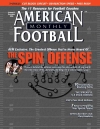
|
The Spin: The Greatest Offense You\'ve Never Heard Ofby: Mike Kuchar© More from this issue The Strategy Head coach Dale Weiner and his staff at Catholic HS in Baton Rouge (LA) began dreaming up the spin offense five years ago during the 2001 season. Bored with the conventional pro “I” sets they had been running, they looked for a different way to run their mis-direction schemes like counter and sweep. So after breaking down the previous night’s game film on Saturday mornings, Weiner and his staff started to lay down the blueprint of a brand-new innovative offense known as the “Spin.” Weiner first unleashed the ‘Spin,’ named because the QB pivots on every snap, in the 2001 state playoffs. The results have been tremendous. Catholic High has posted a 50-9 record, averaging 34.5 points per game. They’ve made the playoffs every year and currently have won 29 straight district games. While the X’s and O’s of the spin may be somewhat complicated, the strategy is quite simple. The “Spin” offense prides itself on mis-direction schemes and similar pattern meshes between the QB and three running backs. Much of it resembles the traditional Wing T scheme, but Weiner operates his out of a double slot set which provides for equal balance on both sides of the ball. “The offense is simple to teach yet it’s different, which I think is the key in coaching,” says Weiner. “All we’ve really done is take a spread package, which everybody in football is doing today, and find a way to mesh it in with the option and misdirection run plays like counter, power and sweep.” Like most run-oriented offenses, the spin relies on an athletic and mobile QB – in Weiner’s offense the QB will carry the ball more than 60% of the time. “For the most part, he’ll be our best athlete,” says Weiner. Both wingbacks are traditional I back types, most likely the first and second team halfback, while the fullback is a conventional fullback and the best blocker on the team. The Run Game Despite the original shotgun set, the run game of the spin offense resembles the buck series of the Wing T. Weiner packages his plays by series, which is not unlike traditional Wing T, but he works mainly out of “deuce” – Weiner’s shotgun double slot set (See Diagram 1). 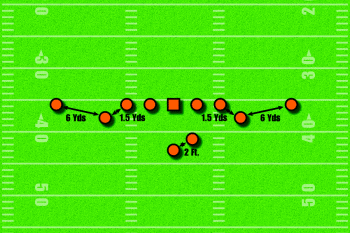
Diagram 1. Shotgun Double Slot Having a balanced set, without overloading one side like Wing T teams would use in traditional TE/Wing sets, makes the defense stay balanced. Defenses cannot overplay one side of the formation because there is no pre-snap read to indicate strength. Plus, according to Weiner, the shotgun set has a tendency to slow defenses down, giving the illusion of a spread pass scheme. Weiner will interchange all three of his backs (besides the QB) so no tendency is shown to run to a certain side. Because of common pull and trap schemes in the spin offense, the offensive line will line up with two foot splits and as deep off the ball as possible. “We try to make sure that once our center gets set, our offensive lineman are so deep in their stances that their hats will usually break the plane of the center’s belt,” says Weiner. “This is so we already have depth on our pull. We don’t worry about giving anything away; people know what we are going to run. They just have to try and stop it.” The QB is lined up with his heels five yards from the ball, while the fullback is offset exactly two feet in front of him on either side (depending on the play). Both slot backs are 1.5 yards from the tackle with their inside foot back. They’ll put their inside foot back so they can pivot off their outside foot and go in motion, which they do on every snap. When a wing goes in motion, he’ll aim for the outside hip of the quarterback, so the pattern of the motion resembles an arc. The receivers split will fluctuate, depending on the play they are running. Anytime the receiver is asked to crack block inside on an outside backer, he will cut his split down; otherwise traditionally he’s at 6 yards from the slot. Weiner’s cadence is simple, “Down… set…hut…hut” so that the motion man could hear his cue, which is when the QB calls “set.” Once ‘set’ is called, the slot comes back in arc motion full speed. “Once that slot takes off on set it’s full throttle for him,” says Weiner. “By the time he gets to the QB’s hip he’s flying.” On spin sweep, the staple run play of the offense, (See Diagram 2) 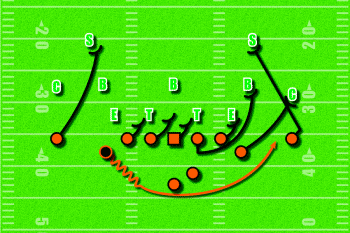
Diagram 2. The Spin Sweep the slot away from the call side comes in full motion on “set” and on the snap, the QB will pivot off on the play side foot and give an outside handoff to the motion man. “We’ll either zone block the front line if it’s a stretch scheme or we’ll pull the front side guard who kicks out the first bad color he sees,” says Weiner. The receiver to the call side will execute a push-crack technique, where he takes two steps like he’s pushing up the field and come crack on the force player, usually an outside linebacker or strong safety. The play side slot will arc to kick out the cornerback. If the defense is playing some type of man coverage, Weiner will have the receivers run their man off to a depth of ten yards then stop and stalk block, while the fullback will make an inside out seal block on the play side defensive end. The counter sweep (See Diagram 3) 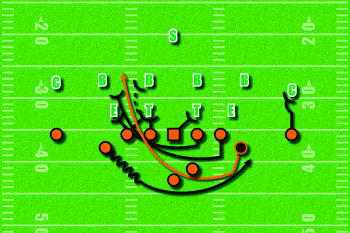
Diagram 3. Counter Sweep is off the same backfield action, which provides for great misdirection. But this time it’s the opposite slot, away from the motion, that’s getting the ball on counter. The QB pivots on a 360 degree turn faking the spin sweep to the motion back and giving an outside handoff to the counter coming the other way. If the defense is showing zone coverage, the play side receiver will crack inside on the force defender. The front side of the line will gap block down, while the backside guard and tackle pull. The fullback will fill backside C gap for the pulling tackle. It’s basically traditional counter run blocking, but Weiner will tweak responsibilities if he sees teams loading up the box up with eight defenders to stop the run. “We usually see a high tendency of split 4-4 with two linebackers stacked on the guards to take away any inside run. What we’ll do in that situation is make a “stay” call to the backside guard telling him to stay home and not pull. We’ll wind up just pulling the tackle who will usually wind up kicking out a much smaller cornerback,” says Weiner. “We know we can’t account for everybody in that look, but that’s the way people will tend to play us so we have to make an adjustment.” Weiner believes the key in running the counter sweep, which he has been running from an “I” backfield set over the last twenty years, is to teach the pulling guard the difference between a kickout block and a log block. He tells his guard that if he can get his hat in the hole of the play he should kick out that defensive end by attacking his near hip and the play comes underneath him. But many teams will do such a good job crashing that end, the guard has to work to get his hips around, aiming for his outside number and seal or “log” the end inside in which the play would have to bounce outside. According to Weiner, the most successful run scheme in the spin offense is the QB power (See Diagram 4). 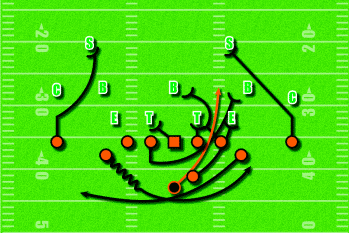
Diagram 4. QB Power Weiner likes to call this on the goal line because it is the most downhill aggressive run in his package. The QB will send the wing away from the call side in motion on “set.” On the snap, he’ll pivot around faking the outside handoff like spin sweep then take the ball right up through the B gap. The front side guard and tackle will combo block the first down defender up through the first backside linebacker, while the fullback kicks out the EMLOS (end man on line of scrimmage). The center blocks back for the pulling backside guard who wraps around and leads up on the play side linebacker in a 4-4 look. The play side slot runs a reverse away with a token fake and the play side receiver pushes his man vertical then runs directly at the near safety, escorting the QB to the end zone. It’s Weiner’s favorite play in the offense. “If you’re behind the defense watching this play unfold, all you see is the criss cross of the slot and bada-bing; it’s a very deceptive play,” says Weiner. “It happens so quick on the goal line teams will usually man us up and the slot motion takes defenders right out of the play.” The Play-Action It’s textbook play-calling at Catholic High. Once teams get a heavy dose of the spin sweep, Weiner will dial up the spin pass right (See Diagram 5). 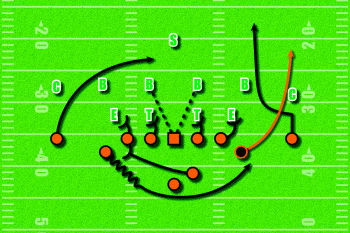
Diagram 5. Spin Pass Right What’s unique about the play-action pass is that the backfield action is exactly the same as the run. The backside slot will come in motion on the “set” count and after getting the snap from the gun, our QB will reverse pivot faking the sweep and take a quick two step drop. The offensive line will zone protect to the call side with the fullback filling the backside C gap like he would on counter sweep. The front side receiver will run an influence crack (on the force defender) and head straight up the seam. This coupled with a wheel route from the play side slot and the backside receiver running a fade proves to be the most effective combination. “The wheel route is almost always there because the slot arcs like it’s a spin sweep then gets right between the hash and the sideline on the wheel.” When teams are getting upfield and getting in his quarterback’s face, Weiner has a change-up to the spin pass by booting the front side guard to get him extra protection. “The back side of the play turn back protects and the tackle comes down on the pulling guard’s man,” says Weiner. “For teams keying the guard’s pull (on a run read) this is a killer.” Although Weiner only has one play-action pass, he has several different route combinations off the same backfield action. Weiner might send the front side receiver on a corner route with the slot running a flat. The backside receiver can run anything from a fade, dig, corner or drag (See Diagram 6). 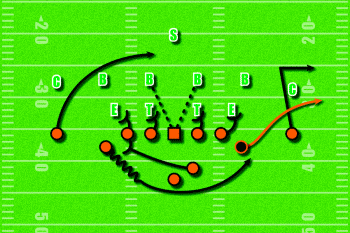
Diagram 6. Play Action Pass Mis-direction/Screens Being that the spin offense already has built-in misdirection schemes, Weiner will throw in additional big play getters to keep defenses on their toes. One of which is the spin reverse. When running the reverse to the left (See Diagram 7) 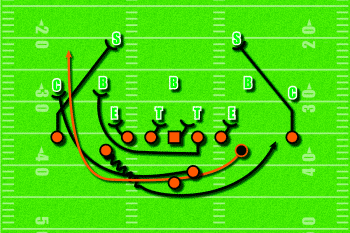
Diagram 7. Reverse (left) the backfield action resembles a spin sweep to the right with the left slot coming in arc motion and faking the sweep. After selling the sweep, the quarterback continues his spin and makes an inside handoff to the opposite slot. Zone blocking the front is the safest bet, and the backside guard will pull and block the force defender. The fullback will block the corner, while the corner will block “MDM” (the most dangerous man), usually a cutoff block on the near safety. Regardless of the down, Weiner will go to the reverse when he sees teams over-shifting their linebackers on the arc motion action. Surprisingly, Catholic’s most successful pass play hasn’t been a play-action or drop back scheme; rather it’s been the FB screen. Weiner will run the screen up to ten times a game, especially when defenses are cheating on the spin sweep. After blocking backside C gap, like he would on spin counter, the fullback sets up on the outside leg of the tackle. The play side tackle, guard and center will pass block for two counts then release with the tackle blocking the corner support, the guard filling the alley and the center pulls around and hinges picking up any backside pursuit (See Diagram 8). 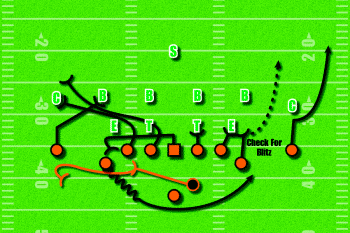
Diagram 8. FB Screen The receiver to the side of the screen will execute a crack block on the force defender while all other receivers will run coverage off. The slot will delay to check for blitz, and then run a seam route. The QB fakes the spin sweep, takes two drop steps and dumps the ball off. This article is part 1 of a 3 part series. Part 2: The Spin Offense: The Running Game Part 3: The Spin Offense: The Pass Game NEW: BUY NOW - WATCH NOW Spin Offense Videos: Click here 
|
|
| HOME |
MAGAZINE |
SUBSCRIBE | ONLINE COLUMNISTS | COACHING VIDEOS |
Copyright 2025, AmericanFootballMonthly.com
All Rights Reserved




